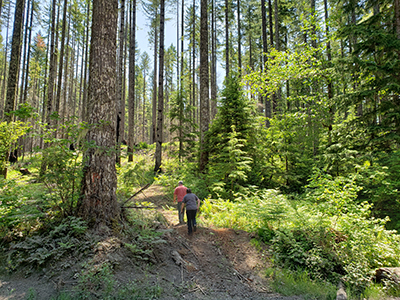Reporter for The Canyon Weekly
On a warm, pleasant June afternoon Oregon Department of Forestry personnel, members of an advisory committee, industry and environmental officials and a reporter gathered on a hill in the Santiam State Forest.
“This is where the restoration began,” said Vince Ferguson of the ODF’s North Cascades District, pointing to the top of the ridge at a Linn County site known as Camp 6.
After the catastrophic 2020 wildfires the ODF had some serious replanting/restoration work to do, work that continues today. Camp 6 was where Ferguson dug the hole for the first of what has become three million seedlings the ODF has planted in the Santiam State Forest, whose 47,000 acres include approximately 16,000 that were affected by the fires.
Camp 6 has gone through some trauma in the past five years. Clearcut in 2017, the ODF followed with replantings, then the fires hit, and now the ODF is replanting again.
“You’re planting the forest and you are planting the understory at the same time,” Ferguson told the tour members. “I’m seeing cherries and maples. Eventually you will have a healthy stand of Douglas fir. Some hemlock and alder will blow in and you will have a diverse forest.”
Camp 6 was a highlight of a tour that included 5 other stops and featured overviews of recreation sites as well as discussions of fire recovery approaches, with a key driver being to provide information to the State Forests Advisory Committee which advises the agency on forest management.
Here is a look at highlights of other stops:
Shellburg Falls/Fern Ridge: The tour gathered on a plateau crisscrossed by the damaged but still visible August Mountain Trail. The ODF is experimenting here with a series of management approaches: modified clearcut in Unit 1, leaving the overstory as is and planting seedlings in Unit 3 and a no-touch approach in Unit 4 that calls for “natural re-emergence.”
Post-fire recovery topics also were discussed in kind of a roundtable in the woods. Ferguson said that most of the plantings were Douglas fir “because that’s what the nurseries had.”
Santiam Unit Forester Kyle Kaupp noted that an annual harvest that had been about 19 million board feet pre-fires skyrocketed to 50 million with the salvage logging that took place and that those 3 million plantings took place in a period in which the agency usually does 400,000 to 500,000.
“Seeing how these meadows respond,” said ODF biologist Tyson Wepprich, “will have a big impact on the forest inventory. And we didn’t have a model for burned forests.”
Ron Zilli, deputy division chief in ODF’s Salem office, noted the challenge of how timely the agency’s response could be given the pattern of its normal processes.
“The ODF had to act quickly,” Zilli said. “We wanted to make sure something was being done, but people were still in shock. It was a battle between going with an established process or on the basis of the emergency. People have different long-standing values with regard to forest management and salvage logging, and we spend a lot of time hashing over things internally.”
The stop also included information on recreation sites in the Shellburg Falls area, the most visited spot in the forest. The area remains closed, with no date set on when it might re-open. Significant trail and infrastructure work remains to be done, with the ODF counting largely on volunteers to do the work.
Santiam Horse Camp: The equestrian-focused recreation area fared pretty well in the fires. The road up from Gates passes through areas that were severely burned, but the camp itself was largely unscathed.
“We’re kind of in a pocket up here,” said Joe Offer, recreation operations manager for the ODF’s Forest Grove office.
The ODF was able to reopen the camp last July and its 9 equestrian campsites and mixed-use trail system remain popular, Offer said.
Mad Creek: The 268-acre site features areas that were thinned, areas that retained a “layered” approach and some that were logged by Bell Lumber and Pole of Longview, Washington. Straight, tall (some as high as 120 feet) trees with consistent trunk diameter are needed to meet the demands of pole loggers, whose products are used for electricity transmission lines.
Bell took out 57 million board feet of poles and 1 million board feet of saw logs, Kaupp noted, but “the ‘defective’ trees left behind are better for wildlife.”
Or, as Dax Strubb, an ODF biologist who works in Salem put it: “You can have a nice even stand that is good for logging but bad for habitat.”





